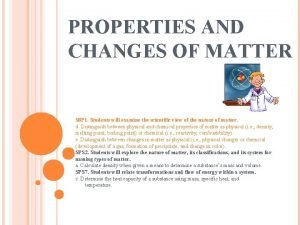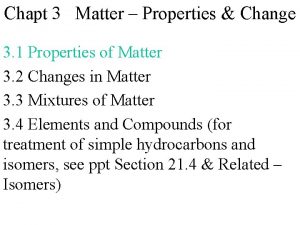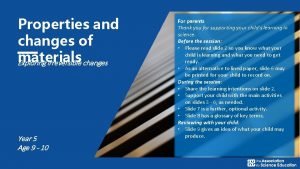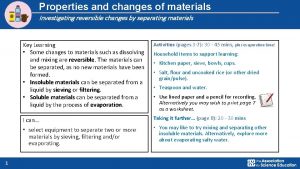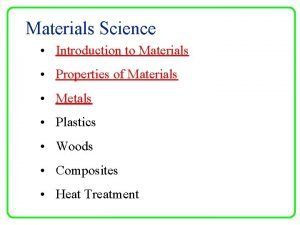Properties and changes of materials Exploring properties and







- Slides: 7

Properties and changes of materials Exploring properties and uses of materials Key Learning Activities (pages 4 -6): 30 - 40 mins • Materials have different uses depending on their properties. Household items to support learning: • Properties include hardness, flexibility, absorbency, strength, transparency, electrical and thermal conductivity and attraction to magnets. • See the word bank of vocabulary on page 3. I can… • use Carroll diagrams to classify materials by their properties. 1 • 10 -12 items made from different materials. See page 5 for suggestions. • Use lined paper and a pencil for recording. Alternatively you may wish to print page 6 as a worksheet. Taking it further… (page 7): 20 - 30 mins • You may like to investigate a household object, a toy or a piece of sports equipment made of two or more materials.

Word bank – properties of materials 2 materials elastic waterproof opaque translucent transparent flexible rigid absorbent magnetic brittle strong smooth rough hard soft dull thermal conductor thermal insulator reflective electrical conductor electrical insulator

Explore, review, think, talk… What do you already know about the properties of materials? (5 – 10 minutes) • Look at these three cups which are made of different materials. • For example, you may have considered transparency to choose the odd one out. • Which do you think is the odd one out? The properties of materials help us to decide which materials are suitable to make a particular object. metal glass plastic There are many possible answers. Think about the properties of the materials to explain your ideas. You can use the word bank on page 3 to help you. 3 • Which important properties do all three cups need to have? Watch this clip to help you decide: https: //www. bbc. co. uk/bitesize/topics/z 4339 j 6 /articles/zx 8 hhv 4

Properties and uses of materials Exploring the materials of household objects (pages 5 -6: 20 - 30 minutes) • Find 10 - 12 items made of various materials. For example: • Sort the objects into groups. You may like to use the word bank on page 3. For example: flexible china wool paper wood metal 4 fabric slightly flexible plastic rigid glass leather cardboard metal plastic • Try this three or four times for different properties.

Classify your household items using two different Carroll diagrams. You may like to use the example opposite for your first one. Use what you have learnt and the word bank to help you. 5 waterproof absorbent rigid flexible strong brittle rough smooth reflective dull elastic non-elastic hard soft magnetic non-magnetic thermal conductor thermal insulator electrical conductor electrical insulator transparent opaque translucent I can use Carroll diagrams to classify materials by their properties. opaque rigid not rigid not opaque

Taking it further… Investigate a household object made of two or more materials (20 – 30 minutes) Many objects are made of more than one material because different parts need different properties. The non-stick coating inside stops the food sticking to the pan. The plastic handle is a thermal insulator so it does not get too hot. The metal pan is a thermal conductor so the heat can travel through it. Use DK Find Out to explore materials: https: //www. dkfindout. com/uk/science/materials/ 6 • Choose a household object, a toy or a piece of sports equipment which is made of two or more materials. • For example, you might like to investigate a bicycle or a skateboard. • Investigate each material to decide why it has been selected. • Draw a labelled diagram to explain what you have found out.

Glossary of terms Absorbent: An absorbent material is able to soak up liquid easily. Brittle: A brittle material is usually hard but can break easily, like china or glass. Electrical conductor: An electrical conductor allows electricity to flow through it. Electrical insulator: An electrical insulator does not allow electricity to flow through it. Flexible: A flexible object or material can be bent easily without breaking. Material: Material is the matter from which a thing is or can be made. Opaque: Light cannot pass through opaque material. Property: A property of an object or material is a feature that makes it suitable for a particular use. Reflective: Light bounces off reflective material making it bright or shiny. Rigid: A rigid object or material cannot be easily bent out of shape. Thermal conductor: A thermal conductor allows heat to pass through it easily. Thermal insulator: A thermal insulator does not allow heat to pass through it easily. Translucent: Some light can pass through translucent material. Transparent: Light can pass through transparent material. 7






